
General Description of Cutback Asphalt MC 3000
Bitumen MC 3000 serves as a high-performance tack coat for grit seals, sand seals, Otta seals, and single seals on lightly trafficked roads, especially during winter construction. Because it has high viscosity and a strong binder content, it provides superior adhesion between aggregates. Moreover, the added cutter ensures that the cover aggregates wet properly while a consistent film of bitumen adheres firmly to the base surface.
How to Use Bitumen MC 3000
You should apply Bitumen MC 3000 with a calibrated distributor at a binder spray temperature of 135 °C and ensure that the road surface temperature is at least 15 °C and rising.
However, always take special care during heating, since Bitumen MC 3000 contains flammable cutters with a flash point above 40 °C.
Additionally, note that the curing time depends largely on weather conditions. In cooler climates, it may take longer for the solvent to evaporate and the binder to set fully.
Differences Between Bitumen MC 3000 and MC 30
Although both belong to the medium-curing category, their compositions and applications differ significantly.
MC 30 generally contains 58% penetration grade 80/100 bitumen and 42% kerosene, which makes it the most fluid among all medium-curing grades.
In contrast, MC 3000 consists of 85% penetration grade 80/100 bitumen and only 15% kerosene, giving it much higher viscosity.
Therefore, MC 30 is ideal for quick penetration and prime coats, while MC 3000 is perfect for thicker coatings and long-lasting adhesion.
Uses of Cutback Asphalt MC 3000
Cutback agents reduce bitumen viscosity, allowing smooth application as a primer on road bases or substrates.
Manufacturers typically use kerosene in various concentrations to achieve the desired curing speed according to local conditions and project needs.
Because it applies easily without the need for thinning or heating, Cutback Bitumen MC 3000 is ideal for prime coats and cold applications.
Furthermore, it effectively waterproofs surfaces, seals capillary voids, and bonds loose mineral particles into a durable surface layer.
Suppliers usually pack it in new thick steel drums on pallets to prevent leaks, or deliver it in bulk via bitutainers or tankers for large-scale projects.
Guarantee and Quality Assurance
ATDM Co. guarantees the quality of Cutback Bitumen MC 3000 through third-party inspection and QC testing before every shipment.
The product fully conforms to ASTM and EN 15322:2009 standards, ensuring consistent performance, safe handling, and long service life.
In addition, ATDM’s international logistics hubs in UAE and Turkey help deliver shipments promptly to global clients.
Analysis of ASPHALT MC 3000
| Properties | Min | Max | Test Method | |
|---|---|---|---|---|
| Kinematic viscosity at 60°C, cSt | 3000 | 6000 | ASTM D2170 | |
| Flash Point (Tag Open-Cup), °C | 66 | — | ASTM D1310 | |
| Distillate, percent by volume (to 360°C) | ||||
| To 190°C | — | — | ASTM D402 | |
| To 225°C | — | — | ASTM D402 | |
| To 260°C | — | 15 | ASTM D402 | |
| To 316°C | 80 | — | ASTM D402 | |
| Residue from distillation to 360°C | ||||
| Penetration at 25°C, 100g, 5 s | 80 | — | — | |
| Ductility at 25°C, cm | 120 | 250 | ASTM D402 / ASTM D113 | |
| Solubility in trichloroethylene, % mass | 100 | — | ASTM D402 / ASTM D2024 | |
| Water, % volume | — | 0.2 | ASTM D95 | |
A: Contractors use Cutback Bitumen MC 3000 for tack coats, surface dressing, and cold mix applications. It forms a strong adhesive layer between aggregates and performs exceptionally well in high-temperature regions or heavy-traffic roads.
A: MC 3000 has a much higher viscosity (around 3,000–6,000 cSt at 60 °C). Consequently, it is thicker, cures more slowly, and forms a stronger film, which enhances surface durability compared to lighter grades like MC 30 or MC 70.
A: Typically, MC 3000 features a kinematic viscosity of 3,000–6,000 mm²/s at 60 °C, a flash point above 66 °C, and a residue after distillation greater than 80%. Together, these properties ensure excellent bonding strength and heat resistance.